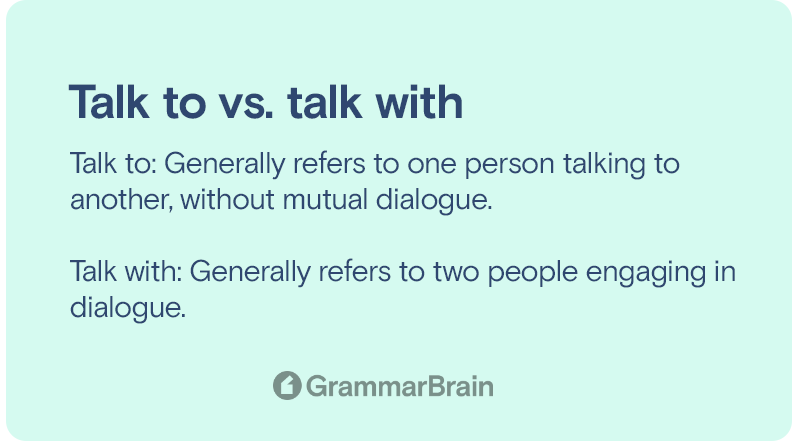Is it talk to or talk with? The phrases “talk to” and “talk with” can get confusing. They are only separated by a tiny modifier, “to” or “with.” The meaning of phrases “talk to” and “talk with” hold the same meaning. Although one phrase, “talk to,” often refers to one person speaking to another, while the other listens (and does not engage). And “talk with” suggest that both people are engaging in the conversation.
Let’s jump in to learn more…
Talk With or Talk To: What Is Correct?
Both the phrases, “talk to” and “talk with,” have similarities. The use of these terms is interchangeable.
However, “talking to” someone involves speaking while the other person listens. On the other hand, when you “talk with” someone, you both get to speak (a mutual discussion).
That means that in a conversation, “talk with” should be used when there is a two-sided discussion, while “talk to” should be used when there is only one speaker.
Let’s look at some sentences to understand how this works.

When to Use “Talk To”
“Talk to” can occasionally suggest having a direct, one-sided conversation about a certain subject while adhering to the rules.
When you say, “I talk with my colleague,” it suggests that you both take turns speaking and eventually have a conversation. However, when someone speaks to us, one person does all the talking while everyone else listens unless one group converses with another.
However, speakers and listeners must have a chance to speak in conversations. This is why “talk with” can be a more grammatically correct phrase.
Here are examples of how to use “talk to”
The teacher said to Ron, “I want to talk to your parents,” for getting bad grades.
You need to talk to your boss about the upcoming project.
You should talk to her parents.
You should not talk to your mother like that.
Jason wants to talk to you about the project.
I don’t know how to talk to her.
Can I talk to you for a minute?
I will talk to Sarah about her performance yesterday.
You should talk to your daughter. I think she is getting depressed.
I don’t think Sara has the courage to talk to her father.
When to Use “Talk With”
The phrase “talk with” can occasionally imply that two or more individuals speak to each other informally and on equal footing while exchanging information about various topics.
The other person does not necessarily have to agree with the point. It’s merely a conversation. And during the conversation, new topics can get raised (called a discussion). These people participate in a discussion or conversation while exchanging information.
Colleagues, classmates, friends, or equals that are having a discussion can get referred to as “talking with.”
When you are conversing with someone equal to you, it’s more appropriate to use the phrase “talk with.” This applies to referring to groups of people who are having a conversation, too.
Examples of how to use “talk with”
I feel so lonely. I have nobody to talk with.
I often talked with my son about his future.
I was talking with Joe about the project you have given us.
I had a talk with Sam yesterday about the party arrangements.
Conclusion
The phrases “talking to” and “talking with” are both correct. You can use them at your will when writing in both formal and informal settings.
Although “talking with” is more commonly referred to groups with an equal or active dialogue. Rather than “talking to,” where one person is speaking, and the others are listening.
FAQs
When to use “talk to” and “talk with”?
Having a conversation with one or more persons might be referred to as talking to or talking with. The phrase “talking to” often suggests a one-sided interaction, like between a supervisor and an employee. The phrase “talking with others” can also mean engaging in dialogue.
Is the term “talk with” grammatically correct?
Yes, the term “talk with” is grammatically correct. We use this term when conversing with someone or a group where everyone speaks.
Which term is more commonly used, “talk with” or “talk to”?
In regular conversation, we use “talk to” more than “talk with.” While “talking to” refers to a one-sided conversation, and “talking with” expresses a conversation from both sides.
Generally, when one person speaks to another person or people to lecture, explain, warn, or direct them. The other person or people listen and nod in agreement. This power difference may also get called out specifically, using the phrase “talk to.”
Inside this article
Fact checked:
Content is rigorously reviewed by a team of qualified and experienced fact checkers. Fact checkers review articles for factual accuracy, relevance, and timeliness. Learn more.
Core lessons
Glossary
- Abstract Noun
- Accusative Case
- Anecdote
- Antonym
- Active Sentence
- Adverb
- Adjective
- Allegory
- Alliteration
- Adjective Clause
- Adjective Phrase
- Ampersand
- Anastrophe
- Adverbial Clause
- Appositive Phrase
- Clause
- Compound Adjective
- Complex Sentence
- Compound Words
- Compound Predicate
- Common Noun
- Comparative Adjective
- Comparative and Superlative
- Compound Noun
- Compound Subject
- Compound Sentence
- Copular Verb
- Collective Noun
- Colloquialism
- Conciseness
- Consonance
- Conditional
- Concrete Noun
- Conjunction
- Conjugation
- Conditional Sentence
- Comma Splice
- Correlative Conjunction
- Coordinating Conjunction
- Coordinate Adjective
- Cumulative Adjective
- Dative Case
- Determiner
- Declarative Sentence
- Declarative Statement
- Direct Object Pronoun
- Direct Object
- Diction
- Diphthong
- Dangling Modifier
- Demonstrative Pronoun
- Demonstrative Adjective
- Direct Characterization
- Definite Article
- Doublespeak
- False Dilemma Fallacy
- Future Perfect Progressive
- Future Simple
- Future Perfect Continuous
- Future Perfect
- First Conditional
- Irregular Adjective
- Irregular Verb
- Imperative Sentence
- Indefinite Article
- Intransitive Verb
- Introductory Phrase
- Indefinite Pronoun
- Indirect Characterization
- Interrogative Sentence
- Intensive Pronoun
- Inanimate Object
- Indefinite Tense
- Infinitive Phrase
- Interjection
- Intensifier
- Infinitive
- Indicative Mood
- Participle
- Parallelism
- Prepositional Phrase
- Past Simple Tense
- Past Continuous Tense
- Past Perfect Tense
- Past Progressive Tense
- Present Simple Tense
- Present Perfect Tense
- Personal Pronoun
- Personification
- Persuasive Writing
- Parallel Structure
- Phrasal Verb
- Predicate Adjective
- Predicate Nominative
- Phonetic Language
- Plural Noun
- Punctuation
- Punctuation Marks
- Preposition
- Preposition of Place
- Parts of Speech
- Possessive Adjective
- Possessive Determiner
- Possessive Case
- Possessive Noun
- Proper Adjective
- Proper Noun
- Present Participle
- Prefix
- Predicate



